The Art of Tea Leaf Reading
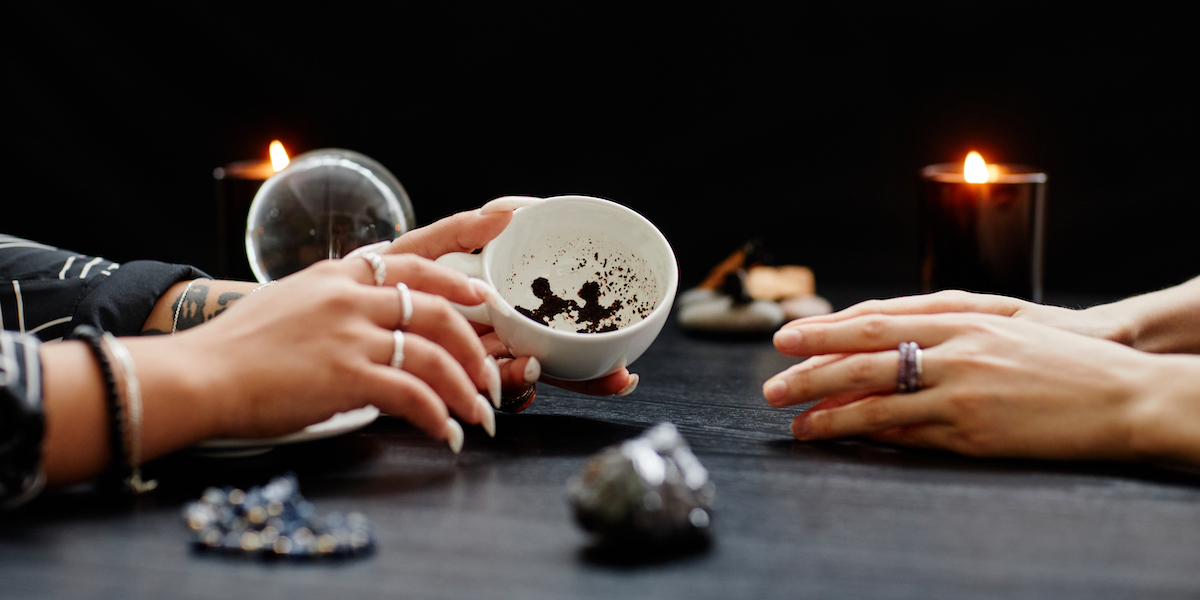
Estimated reading time: 8 minutes
Imagine the air filled with the pleasant aroma of your favourite tea blend. Steam rises from your cup, and within it, a story waits to be told. Tea leaf reading, also known as tasseography, is an ancient practice. It resonates across cultures. It bridges the everyday comfort of a warm cup with the mystical art of divination.
In this enchanting guide, we delve into the world of reading tea leaves. It’s a pursuit of knowledge that only needs belief in something beyond the visible. This belief unlocks a world of symbols, messages, and insights.
Table of Contents

What is Tea Leaf Reading?
Also known as tasseography, it is a divination practice. Tasseography interprets patterns in tea leaves. They remain in the cup once the beverage has been consumed.
This ancient technique has roots in Asia and the Middle East. It involves swirling the loose leaf tea in a cup. Next, interpret the symbols and configurations as they settle on the bottom and sides.
Proponents of tea leaf reading believe these patterns can provide insights into the drinker’s future. They believe the patterns provide guidance on personal relationships, career decisions, and financial matters.
Holistic and spiritual wellness has gained renewed interest. It has become popular as both entertainment and self-reflection. This makes it a fascinating subject for those interested in traditional and esoteric practices.
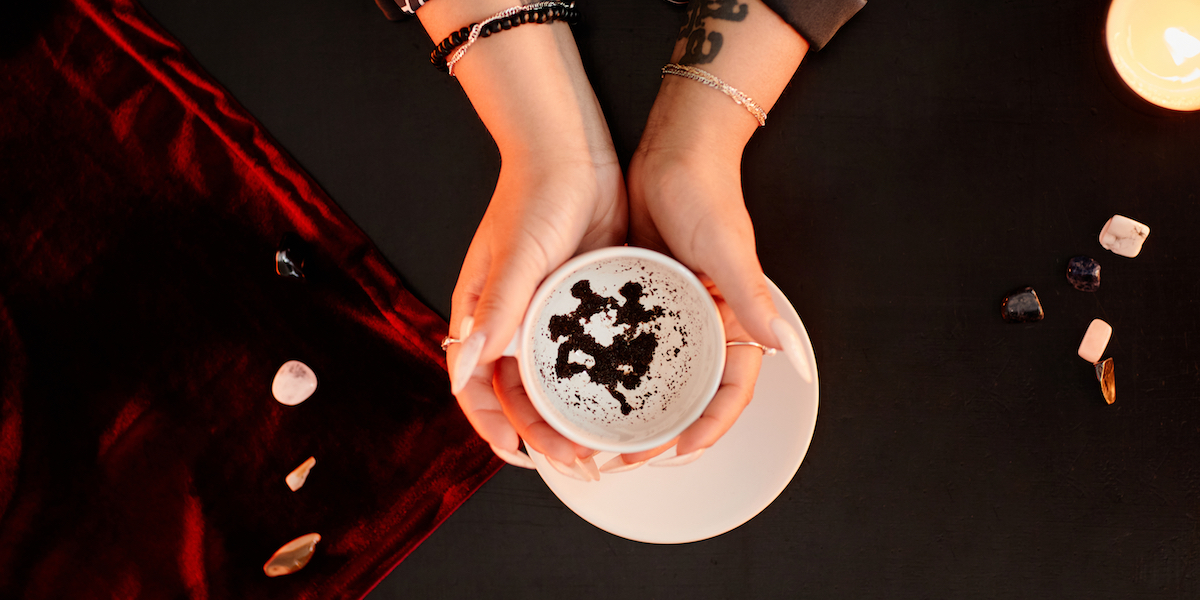
History of Reading Tea Leaves
Tea leaf reading has its origins in ancient China. Tea has been a staple there for millennia. Legend suggests that tea leaves in a cup would tell a person’s fortune. Patterns and symbols reveal future events and insights into one’s life. This practice caught on and subsequently spread along trade routes to Europe. It particularly resonated within Eastern European countries.
Yet, it wasn’t until the 17th century that tea became a fashionable drink in the salons of Europe. Only then did reading tea leaves become a widespread practice in the West. The Victorians in England were drawn to romantic and mystical rituals. They popularised it further as a parlour activity, often accompanied by afternoon tea.
With the advent of the 20th century, it has found a space within a blend of New Age and Wiccan practices. It became less common in the modern era. Now, it’s becoming popular again as part of a broader revival of interest in esoteric arts.
Today, some view it as a charming vestige of a bygone era. Others take it seriously, integrating it into their spiritual or mindful practices. They attest to its lasting allure.
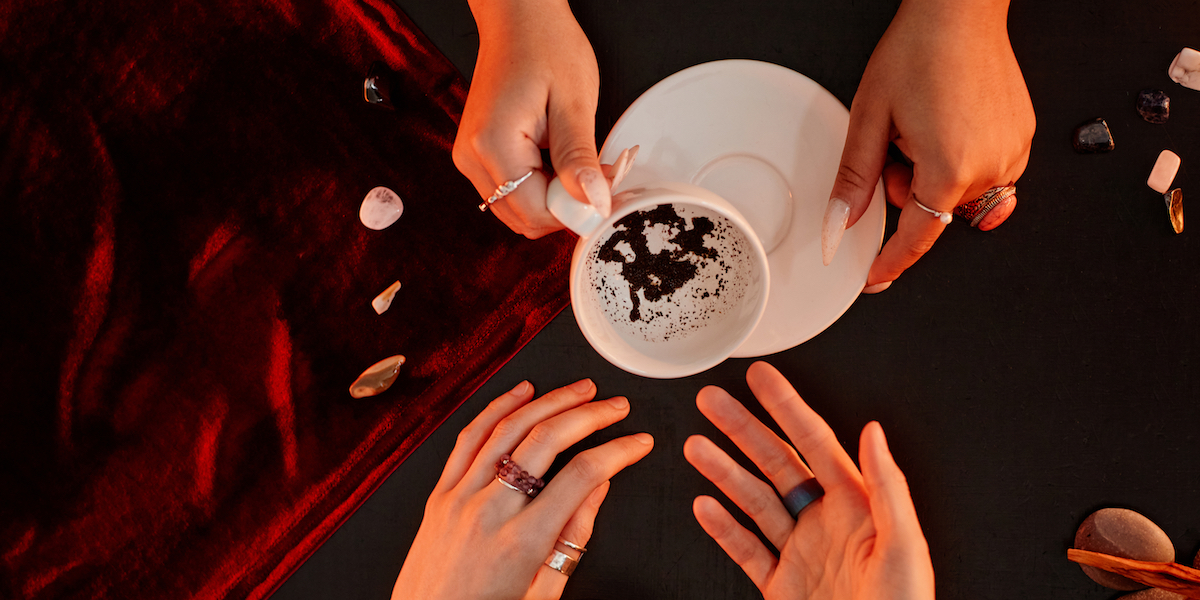
Tea Leaf Reading Symbols and Meanings
It is a divination practice that dates back centuries. Patterns left by tea leaves in the cup are interpreted to tell one’s fortune. Here’s a detailed list of common symbols and their meanings:
- Anchor: Stability and hope; if blurred or indistinct, the meaning turns to uncertainty.
- Bird: Good news or a journey; many birds could signify travel to exotic or distant locations.
- Cat: Deceit or a false friend; if the cat appears playful, it may suggest a need to be less serious.
- Dragon: Strong passions, potentially signifying a tempestuous relationship or event.
- Elephant: Good health, strength, and prosperity; requires help with an important matter.
- Flowers: Represent personal growth, happiness, and joy. If the flowers are at the top of the cup, happiness is more imminent.
- Heart: Love and relationships; the clearer the heart, the deeper the love.
- House: Security, comfort, and protection; may also refer to family and home life.
- Key: Opportunities and discoveries; can also signify unlocking one’s potential.
- Leaves: Personal growth and the start of a new project or journey.
- Moon: Changes and cycles may represent caution.
- Owl: Wisdom and knowledge, potentially a sign to trust one’s intuition.
- Rabbit: Abundance and fertility, but can indicate a need for bravery.
- Stars: Good luck, hope, and destiny falling into place.
- Tree: indicates growth and vitality. A bare tree may signify a feeling of exposure or vulnerability.
Also worth considering
Remember, the positioning of these symbols within the teacup also alters their interpretation. Symbols nearer the rim represent the future. Those closer to the base reflect the past or deep-rooted issues.
In addition to the symbols mentioned above, various other factors can influence a tea leaf reading. For example, the type of tea used may have its own symbolic meaning. Black tea may represent strength and protection. Green tea could symbolise growth and new beginnings.
The shape and size of the cup can also play a role in tasseography. A shallow cup may signify a superficial reading. A deep and narrow cup could suggest a more personal and in-depth analysis.
Furthermore, bubbles or dregs in tea may also reveal one’s fortune. Bubbles may indicate a coming windfall or unexpected turn of events. Dregs might suggest obstacles or challenges ahead.
It’s important to note that while it can be fun and intriguing. You should not be used as a substitute for professional advice or guidance. It is simply meant to provide reflection and self-discovery. This allows one to tap into their intuition. It helps them gain insight into their current and potential future circumstances.
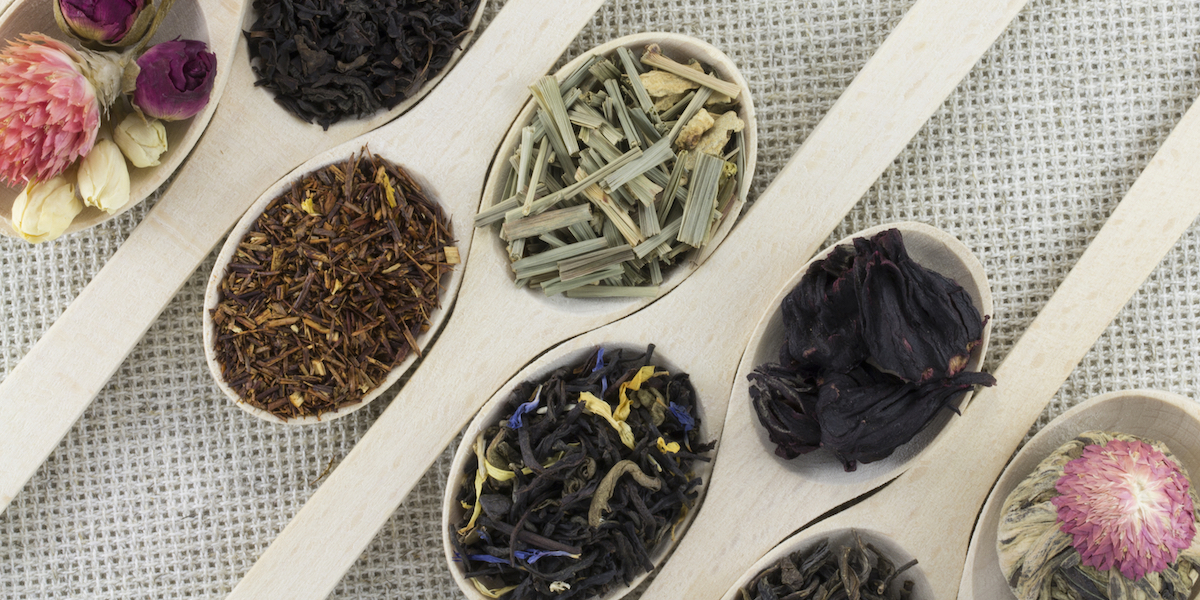
Best Tea for Leaf Tea Reading
The best choices are loose-leaf teas with larger leaves, as they tend to leave more distinguishable patterns in the cup.
- Assam Tea: A favoured for its robust leaves and rich flavour. They produce clear and defined symbols.
- Oolong Tea: Offers a fine balance with its partially oxidised leaves. This allows nuanced interpretation without the leaves being too small.
- White Tea: With its larger leaves and lighter body, can also be suitable. It provides subtle patterns. These challenge the reader’s intuition without overwhelming with too much residue.
These varieties are exceptional options for tea leaf reading. Each offers a distinct clarity conducive to this time-honoured tradition.
Some other teas commonly used for tasseography include:
- Green Tea: A delicate and intricate visual display in the water. It allows detailed interpretation.
- Herbal Tea: Such as Chamomile or Peppermint, can add complexity to the readings. They have unique patterns and flavours.
- Flower Teas: Like Rose or Jasmine, provide a feminine touch to the reading. They have delicate petals and fragrant scents.
- Pu erh Tea: With aged and fermented leaves. It adds a deep and mysterious tone to the readings. This makes it perfect for more introspective and profound interpretations.
Tasseography uses different teas to create various patterns and symbols. These are used for interpretation. They also allow a deeper connection to the natural world. Each tea has its own unique characteristics and energy. This can add layers of meaning to the reading.
In addition, brewing and sipping on tea can create a calming and meditative atmosphere. This allows for a more focused and intuitive reading experience.
Using different teas can also reflect the reader’s personal preferences and tastes. This adds a personal touch to the reading. Experimenting with different types can enhance the visual aspect of the reading. It can also add depth and individuality to this ancient divination practice. Next time you sit down for a cup of tea, think beyond just the taste. Consider what messages may await you in the leaves.
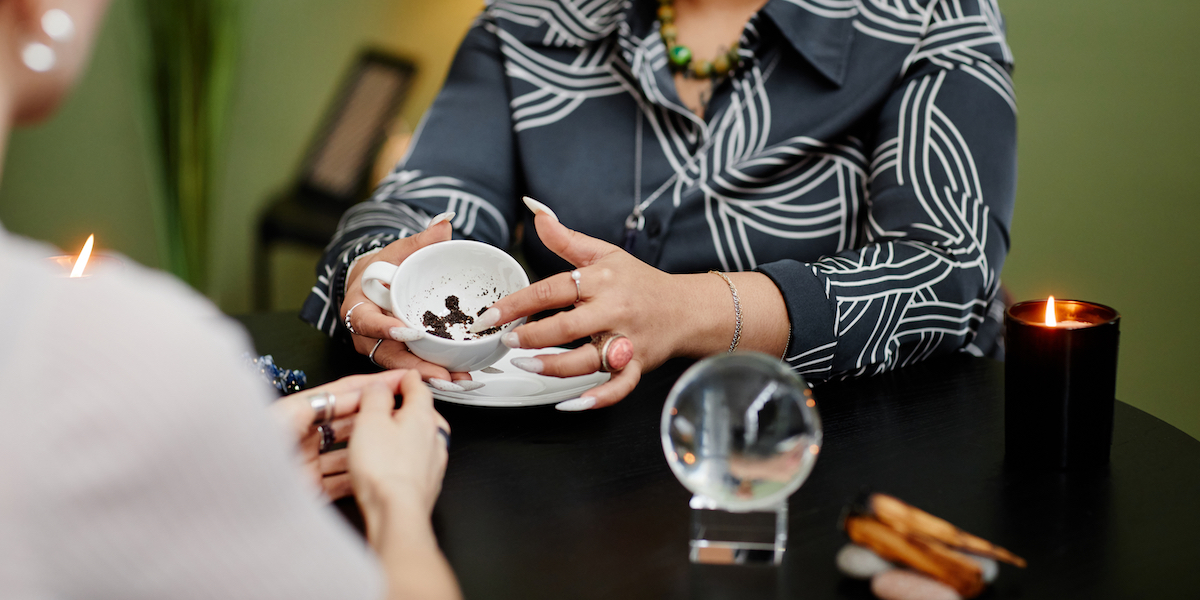
Getting Started with Tea Leaf Reading
Tea leaf reading can feel daunting to newbies. It’s like deciphering a unique language. However, everyone has the innate ability to interact with the spiritual realm. Here’s a beginner-friendly guide to help you get started.
A Step-By-Step Guide for Beginners
- Sit in a quiet, comfortable space with minimal distractions.
- Concentrate on your question or the area of your life you’re seeking guidance about.
- After finishing your tea, swirl the remaining liquid three times. Then, gently invert the cup onto the saucer.
- Hold the cup in your non-dominant hand. Turn it counter-clockwise (to the right) three times to redistribute the leaves. Then, contemplate your symbols.
Tips for Enhancing Intuition and Connection
- Meditate or perform breathing exercises before a reading to quiet the mind.
- Keep a journal to record your readings and the events that follow.
- Respect your readings as a form of guidance, rather than absolute truth.
Conclusion
In a world often defined by technology and instant gratification, the garden offers a serene space for contemplation. It also connects visitors to history and cultural practices that transcend time.
Reading tea leaves invites you to slow down, look inward, and open your mind to endless possibilities. It teeters on the edge of the seen and the unseen. You can approach tea leaf reading with playful curiosity or as part of a deeply spiritual routine. It is an opportunity to explore.
In every cuppa, there’s a story waiting to be sipped and savoured. Perhaps, there’s a vision of what lies ahead for you. So why not brew a cup of your favourite tea and see what the leaves have to say?

 Loose Leaf Tea
Loose Leaf Tea Pyramids
Pyramids Tea Bags
Tea Bags Africa
Africa Assam
Assam Ceylon
Ceylon Chinese
Chinese Darjeeling
Darjeeling European
European Indian
Indian Japan
Japan Nepal
Nepal South East Asia
South East Asia Ayurveda Tea
Ayurveda Tea Black Tea
Black Tea Chai Tea
Chai Tea Flowering Tea
Flowering Tea Fruit Tisanes
Fruit Tisanes Green Tea
Green Tea Herbal Tea
Herbal Tea Matcha Tea
Matcha Tea Oolong Tea
Oolong Tea Organic Tea
Organic Tea Pu erh Tea
Pu erh Tea Rooibos Tea
Rooibos Tea White Tea
White Tea Asian Coffee
Asian Coffee Caribbean Coffee
Caribbean Coffee Central American Coffee
Central American Coffee South American Coffee
South American Coffee Coffee Blends
Coffee Blends Decaffeinated Coffee
Decaffeinated Coffee Espresso Coffee
Espresso Coffee Ethically Sourced Coffee
Ethically Sourced Coffee Flavoured Coffee
Flavoured Coffee Organic Coffee
Organic Coffee Single Origin Coffee
Single Origin Coffee Chocolate 1
Chocolate 1 Chocolate 2
Chocolate 2 Chocolate 3
Chocolate 3 Chocolate 4
Chocolate 4 Chocolate 5
Chocolate 5 Chocolate 6
Chocolate 6 Chocolate 7
Chocolate 7 Chocolate 8
Chocolate 8 Chocolate 9
Chocolate 9 Loose Tea Filters
Loose Tea Filters Tea Accessories
Tea Accessories Tea Bricks
Tea Bricks Tea Caddies
Tea Caddies Tea Caddy Spoons
Tea Caddy Spoons Tea Gift Ideas
Tea Gift Ideas Tea Infusers
Tea Infusers Tea Strainers
Tea Strainers